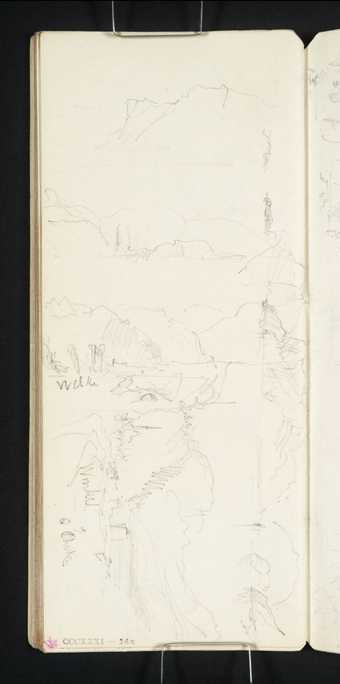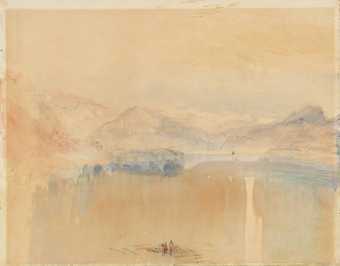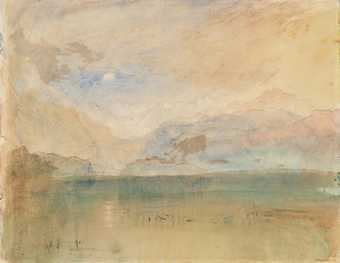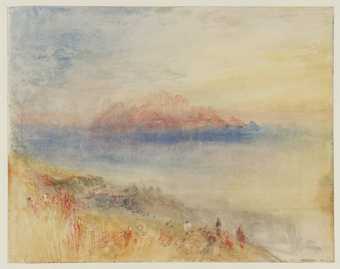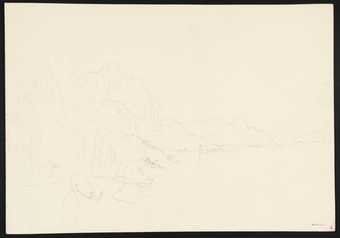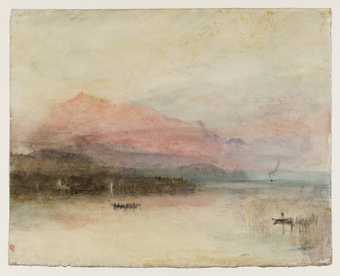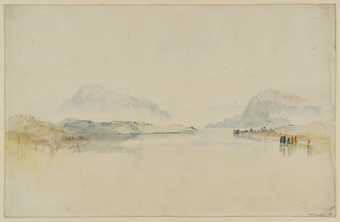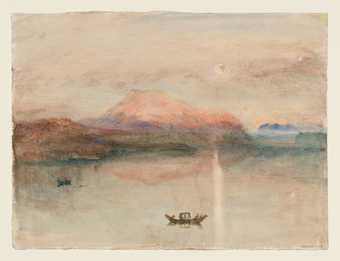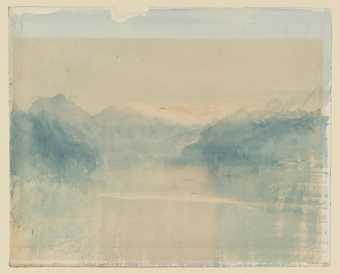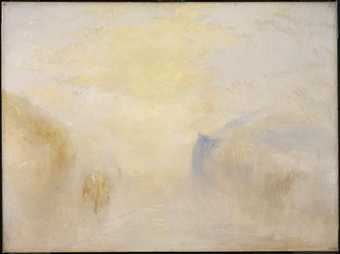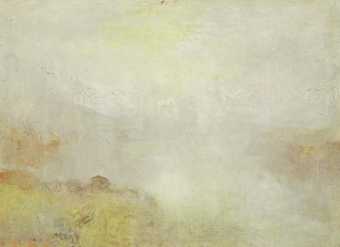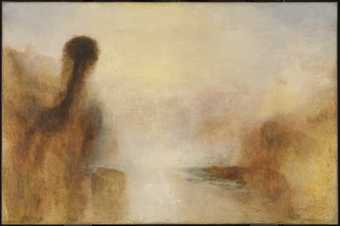
On loan
National Art Center (Tokyo, Japan): Light
- Artist
- Joseph Mallord William Turner 1775–1851
- Medium
- Oil paint on canvas
- Dimensions
- Support: 911 × 1226 mm
frame: 1074 × 1377 × 78 mm - Collection
- Tate
- Acquisition
- Accepted by the nation as part of the Turner Bequest 1856
- Reference
- N04665
Display caption
While the topographical details of this painting are hazy and indistinct, the sunset is vividly depicted, lighting up the sky in vibrant reds and oranges, reflected across the water. At the right, passages of white paint may depict snowy Alpine mountains, perhaps those around Lake Lucerne, a destination favoured by the artist during the 1840s.
Gallery label, February 2010
Does this text contain inaccurate information or language that you feel we should improve or change? We would like to hear from you.
Catalogue entry
[from] Nos. 453–86: Late Unfinished Sea Pieces, c. 1830–45
THERE are two main problems about this group of works. The first is the question of dating: the dates adopted here are highly tentative and are based on the supposition that there is a logical progression from a more substantial, three-dimensional style to one that is more impressionistic and less solid, together with a feeling that Turner's colouring was perhaps at its strongest from the early to the mid 1830s. However, as will be noted, the compilers do not always agree on even the tentative datings given here. In any case, what may look like a less three-dimensional picture may in fact be merely a less finished picture.
The second problem is that of provenance and authenticity, in particular as it concerns smaller pictures outside the Turner Bequest, Nos. 474–84, together with the somewhat similar works no longer accepted as genuine, Nos. 555–8. That some such unfinished works escaped the Turner Bequest is certain, and a foundation is provided by those works that can be definitely or tentatively traced to John Pound, the son by her first marriage of Mrs Booth, Turner's mistress and housekeeper. In reviews of our first edition, exception was taken to some of our attributions by Luke Herrmann (Nos. 475, 478 and 484) and Jerrold Ziff (Nos. 480 and 481); interestingly, they do not agree. Of the works they doubt, No. 478 seems definitely to have been in the Pound sale at Christie's in 1865, while Nos. 480, 481 and 484 bear labels or are said to come from the Pound family.
However, one should never let an apparently sound provenance stand in the way of one's judgment based on the visual evidence, and in this case there is one further element, the fact that, from 1848, for apparently the only time in his life, Turner employed an assistant, Francis Sherrell. According to Bernard Falk (1938, p. 213), whose reference is based on an obituary in the Isle of Thanet Gazette for 23 September 1916, Turner gave Sherrell lessons in return for various services such as stretching his canvases and running errands; John Gage (1969, p. 171) suggests that Sherrell may also have cleaned some of the pictures in Turner's studio at the instigation of the dealer Thomas Griffith, who was active in trying to obtain sales for Turner at this time. Nothing further seems to be known about Sherrell save that he died at Thanet in 1916. It is perhaps an unworthy suspicion to suggest that he, more than anybody else, would have been in a position to imitate Turner's late style and that such imitations could have been left in Turner's studio and acquired by the Pound family.
Another suspicious circumstance is that, although Turner tended to work on standard sizes of canvas, only a few of those of this group of pictures that are outside the Turner Bequest can be matched with works in the Bequest: No. 472, near enough Turner's standard three feet by four feet; No. 474, much the same size as Nos. 457 [N02881] and 458 [N02882]; Nos. 475, 482, and 556a, close to No. 459 [N05495]; and Nos. 483 and 484, the same size as Nos. 485 [D36675] and 486.
Lit. Rothenstein and Butlin 1964, p. 62; Herrmann 1978, p. 773; Wilton 1979, p. 224; Ziff 1980, p. 167.
469. [N04665] Sun setting over a Lake c. 1840
THE TATE GALLERY, LONDON (4665)
Canvas, 35 7/8 × 48 1/4 (91 × 122·5)
Coll. Turner Bequest 1856; transferred to the Tate Gallery 1947.
Exh. New York 1966 (34, repr. in colour p. 46); Dresden (19) and Berlin (29, colour pl. 16) 1972; Lisbon 1973 (19, repr. in colour); Hague 1978–9 (xvi, repr. in colour).
Lit. Gowing 1966, p. 38, repr. in colour p. 46; Herrmann 1975, p. 55, colour pl. 178.
Whether the picture shows the sun setting over a lake or the sea is difficult to determine, but the presence of what appear to be mountains on the right suggests the former. If so, the picture could be a rather more dramatic and colourful variant of the theme of Inverary Pier (No. 519).
Published in:
Martin Butlin and Evelyn Joll, The Paintings of J.M.W. Turner, revised ed., New Haven and London 1984
Explore
- abstraction(8,615)
-
- from recognisable sources(3,634)
-
- landscape(1,191)
- formal qualities(12,454)
- countries and continents(17,390)
-
- Switzerland(1,058)
- Alps(836)
- Lake Lucerne(84)
You might like
-
Joseph Mallord William Turner Winkel [Turner] (near Lucerne, on the Lake)
c.1841 -
Joseph Mallord William Turner Fluelen. (Head of Lake Lucerne)
1841 -
Joseph Mallord William Turner Lake of Lucerne, Looking from Kussnacht towards the Bernese Alps; Mont Pilatus on the Right, Dark against the Sunset
1841 -
Joseph Mallord William Turner Sunset, Lake of Lucerne
1841 -
Joseph Mallord William Turner Mont Pilatus: Sunset
1841 -
Joseph Mallord William Turner Mountains beside Lake. (?Lucerne)
c.1841 -
Joseph Mallord William Turner The Pink Rigi
c.1844 -
Joseph Mallord William Turner The Rigi: Last Rays
c.1841–2 -
Joseph Mallord William Turner Lake Lucerne, with the Rigi
c.1841–2 -
Joseph Mallord William Turner The Red Rigi: Sample Study
c.1841–2 -
Joseph Mallord William Turner Morning on the Lake of Lucerne
after c.1830 -
Joseph Mallord William Turner Sunrise, with a Boat between Headlands
c.1840–5 -
Joseph Mallord William Turner Lake Lucerne: the Bay of Uri from above Brunnen
c.1844 -
Joseph Mallord William Turner Sunset From the Top of the Rigi
c.1844 -
Joseph Mallord William Turner Landscape with Water
c.1840–5

